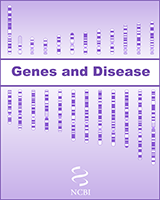NCBI Bookshelf. A service of the National Library of Medicine, National Institutes of Health.
National Center for Biotechnology Information (US). Genes and Disease [Internet]. Bethesda (MD): National Center for Biotechnology Information (US); 1998-.

Breast cancer is the second major cause of cancer death in American women, with an estimated 44,190 lives lost (290 men and 43,900 women) in the United States in 1997. Although ovarian cancer accounts for fewer deaths than breast cancer, ovarian cancer still represents 4% of all female cancers. For some of the cases of both types of cancer, there is also a clear genetic link.
In 1994, two breast cancer susceptibility genes were identified: BRCA1 on chromosome 17 and BRCA2 on chromosome 13. When individuals carry a mutation in either BRCA1 or BRCA2, they are at an increased risk of being diagnosed with breast or ovarian cancer at some point in their lives. Until recently, it was not clear what the function of these genes was, until studies on a related protein in yeast revealed their normal role: they participate in repairing radiation-induced breaks in double-stranded DNA. It is thought that mutations in BRCA1 or BRCA2 might disable this mechanism, leading to more errors in DNA replication and ultimately to cancerous growth.
Thus far, the best opportunity to reduce mortality is through early detection (general screening of the population for BRCA1 and BRCA2 is not yet recommended). However, new strategies to find anticancer drugs are constantly being developed. The latest strategy, called "synthetic lethal screening", looks for new drug targets in organisms such as yeast and fruit flies. In the same way that studies in yeast recently helped to identify the functions of BRCA1 and BRCA2, it is thought that drugs that work in more primitive organisms will also be applicable to humans.
- Genome view see gene locations
- Entrez Gene collection of gene-related information
- BLink related sequences in different organisms
- Research articles online full text
- Books online books section
- OMIM catalog of human genes and disorders
- GeneReviews a medical genetics resource
- OMIMRelated OMIM records
- Breast and ovarian cancer - Genes and DiseaseBreast and ovarian cancer - Genes and Disease
Your browsing activity is empty.
Activity recording is turned off.
See more...
